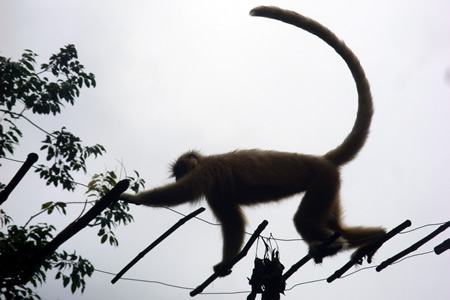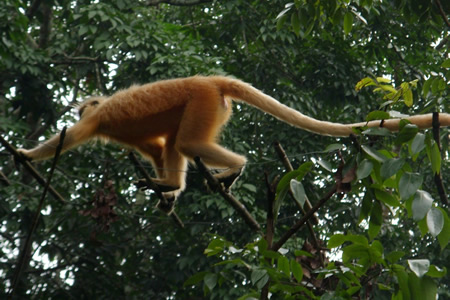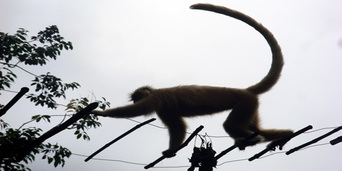13
Dec
Connecting canopies – ropeways to save the endangered langurs
0 Comment
 A golden langur uses the canopy bridge
A golden langur uses the canopy bridge
Bodoland (Assam), November 8, 2012: Ropeways for humans are nothing new, but those for monkeys are not something we hear about all too often.
Golden langurs – endemic to Indo-Bhutan region, have been using ropeways to safely cross a 500-m stretch of road near Chakrasila Wildlife Sanctuary (WLS).
The killer stretch had claimed numerous golden langurs earlier. Since the installment of the ropeways in January this year no death due to accidents has been reported.
The golden langur (Trachypithecus geei) is an endangered primate with its distribution restricted between River Manas and Sonkosh, on the northern bank of Brahmaputra in Assam including Chakrasila WLS, and in certain parts of Bhutan. It feeds on fruits, leaves, seeds, flowers etc. It is listed under schedule I of the Indian Wildlife Protection Act, 1972.
On the northern boundary of Chakrasila, the 500-m road separates the sanctuary from plantation forests used by the resident langurs as an extension of their habitat. The langurs were compelled to descend on to the ground and cross the road risking accidents, attacks by feral dogs or even poaching.
“Golden langurs are essentially arboreal and are not agile on ground. What we know is that there were 10 cases of these magnificent animals killed in this stretch since 2005 as per our records. Who knows how many cases went undetected, or how many other individuals lost to other causes due to this fragmentation,” said Dr Bhaskar Choudhury of the International Fund for Animal Welfare – Wildlife Trust of India (IFAW-WTI).
 The canopy bridge near Chakrasila Wildlife Sanctuary
The canopy bridge near Chakrasila Wildlife Sanctuary
As part of their Greater Manas Conservation Project, the Bodoland authorities and IFAW-WTI initiated a Rapid Action Project (RAP) in January this year to help save the langurs.
Ropeways of bamboo and ropes were created and strategically placed between canopies of trees in areas regularly used by the langurs to cross over. These ropeways were placed at a height of 60 m from the ground.
“Initially, understandably the langurs hesitated to use these bridges. But now they appear to have been habituated and are frequently seen to use them,” said Dr Panjit Basumatary, IFAW-WTI veterinarian of Bodo origin who brought the issue to light. “We consider golden langurs as a pride of Bodoland, and it feels great to have been a part of the team saving them.”
There have been similar interventions in other parts of the world. At home in India, bamboo bridges have been placed to connect canopy over roads for use by the lion-tailed macaques in the Nilgiris.
“This shows the extent of fragmentation of natural habitats and the difficulties faced by wildlife. Nothing would be better than natural contiguous canopy, but such interventions are becoming more and more common and the only way out in many of the cases,” said primatologist Mayukh Chatterjee.
Photos courtesy Jyotish Prasad Das









